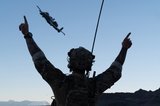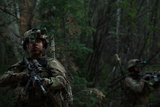Just released: UAS Technology Report 2024 now available to read
In Shephard's latest Technology Report, Gerrard Cowan examines the potential offered up by the latest generation of naval UAS, coupled with advanced payloads and the advent of specially designed or adapted host vessels.
Turning first to the mine countermeasure (MCM) mission set, he examines the benefits of integrating UAVs into a multi-domain sensor and effector network, including the role of technologies such as LIDAR and the long-term possibility of autonomous platforms neutralising sea mines from the air.
Talking to Shephard for the report, Daniel Scourzic, MCM and deepwater product line director at Exail, said a UAS can be ‘used to detect or identify drifting mines or mines that are below the surface, the depth of detection depending on the water turbidity. It can also be used to detect mines in very shallow waters where USVs or AUVs cannot be deployed.’
However, he noted that their full potential would only be realised with future developments such as new types of sensors, as well as ‘performing data fusion coming from different types of sensors. In future they could also possibly be used for neutralising or for helping to neutralise drifting mines.’
The report also discusses the emergence of ships deployed as carriers for aerial and other uncrewed systems, looking at how industry is tackling challenges such as UAV integration, command and control, and all-weather operations.
Neil Hunter, global head of sales at Schiebel, said that motherships should be able to house a variety of uncrewed assets, including UAVs, USVs and UUVs. A VTOL aircraft like the company’s Camcopter S-100 has a minimal footprint, he argued, ‘both for storage as well as not needing a runway or launch equipment’.
From an operational perspective, Hunter said a UAV of this type can be incorporated next to conventional assets when needed. A small field maintenance team can keep the ship’s overall crewing requirement to a minimum, while ‘compliance with recognised standards such as STANAGs allows interoperability where required’.
More from Technology Reports
-
![Just Released: Military Training Technology Report December 2024 now available to read]()
Just Released: Military Training Technology Report December 2024 now available to read
In this latest Shephard technology report, Giles Ebbutt highlights the rise of the first person view (FPV) drone as a powerful asymmetric weapon that can …
-
![Just Released: Military Training Technology Report October 2024 now available to read]()
Just Released: Military Training Technology Report October 2024 now available to read
How the latest portable simulation solutions can deliver JTAC training wherever it is needed
-
![Just Released: Space Technology Report]()
Just Released: Space Technology Report
Why space is an essential part of modern military capabilities
-
![Just released: Night Vision & Situational Awareness Technology Report 2024 now available to read]()
Just released: Night Vision & Situational Awareness Technology Report 2024 now available to read
How night vision devices and soldier-worn sensors are underpinning advanced tactical C4ISR capabilities
-
![The imperative for a vibrant UK space industry]()
The imperative for a vibrant UK space industry
Ahead of a new Shephard Technology Report to be published in September, senior executives from Lockheed Martin Space have underlined the importance of investing in defence space systems by countries like the UK.
-
![Just released: Military Training Technology Report 2024 now available to read]()
Just released: Military Training Technology Report 2024 now available to read
How cutting-edge technologies are combining to produce ultra-realistic simulation.


























